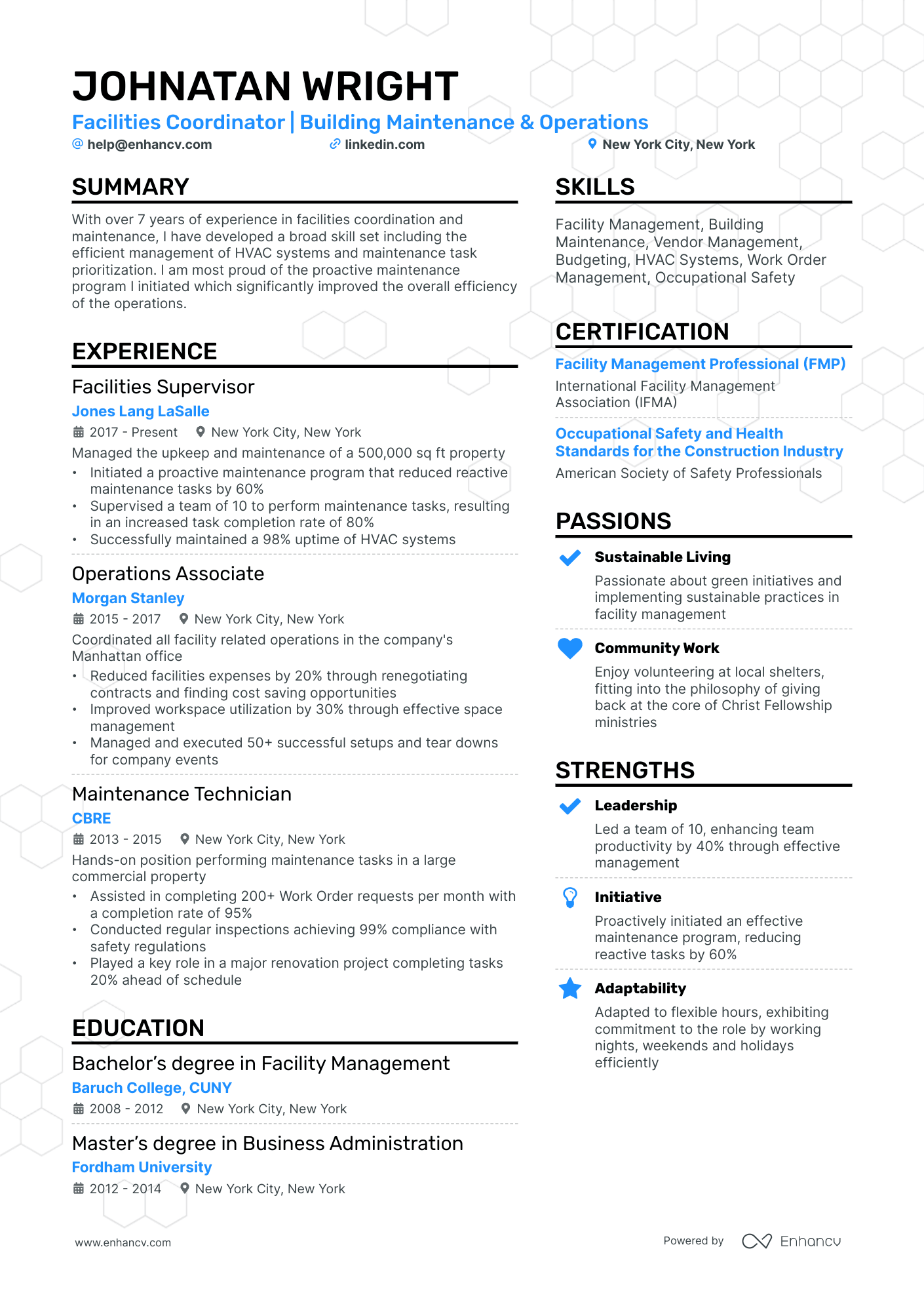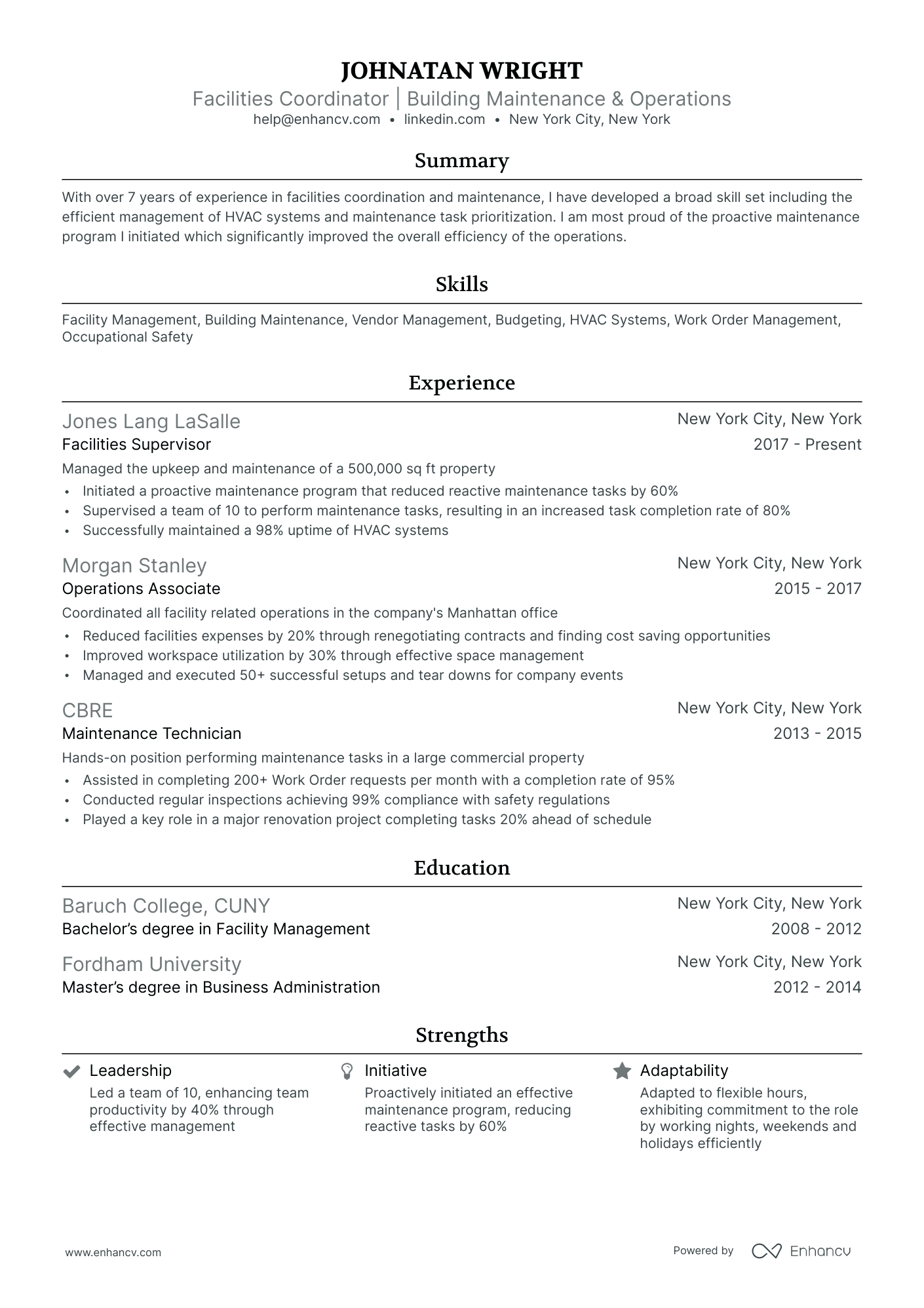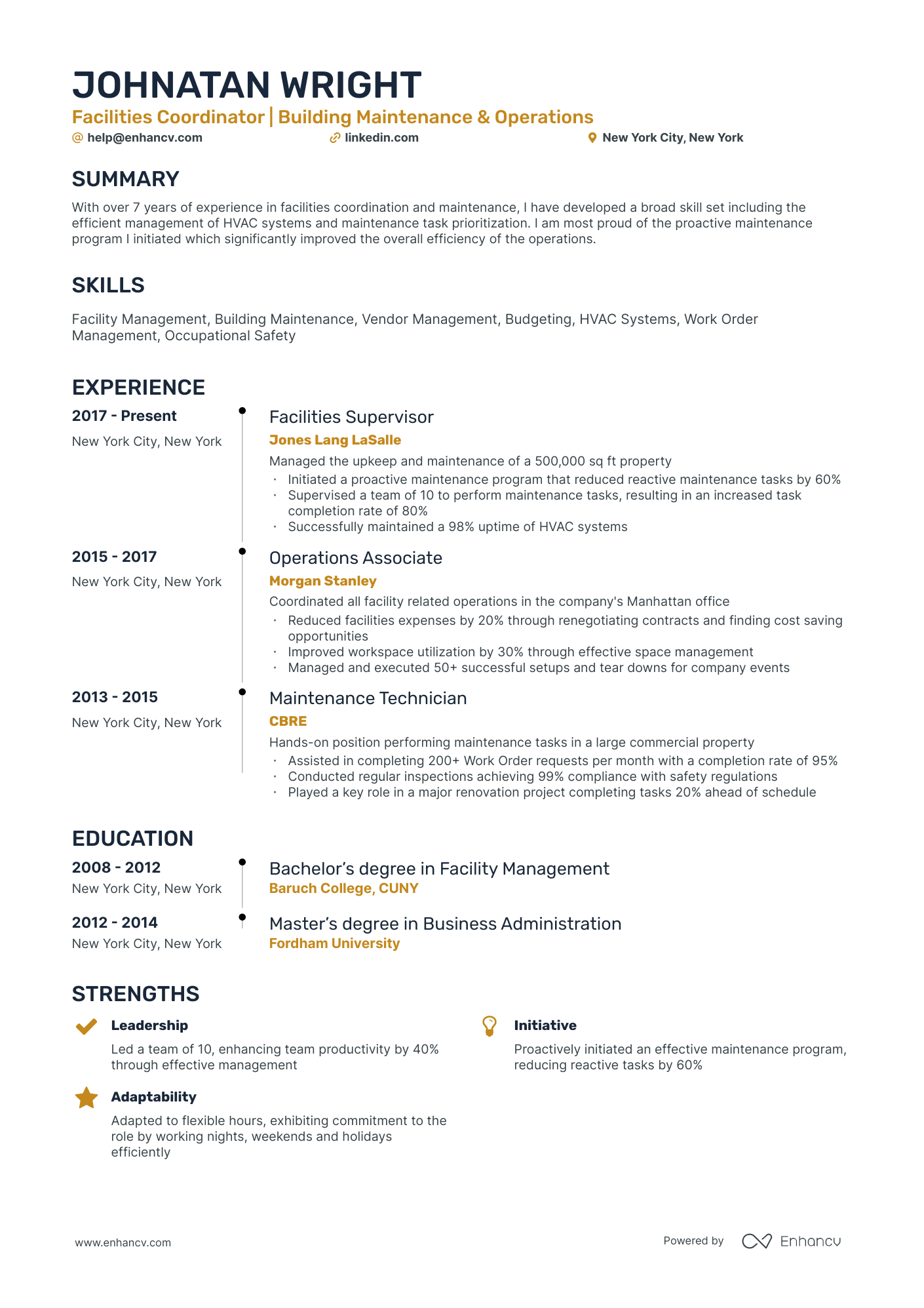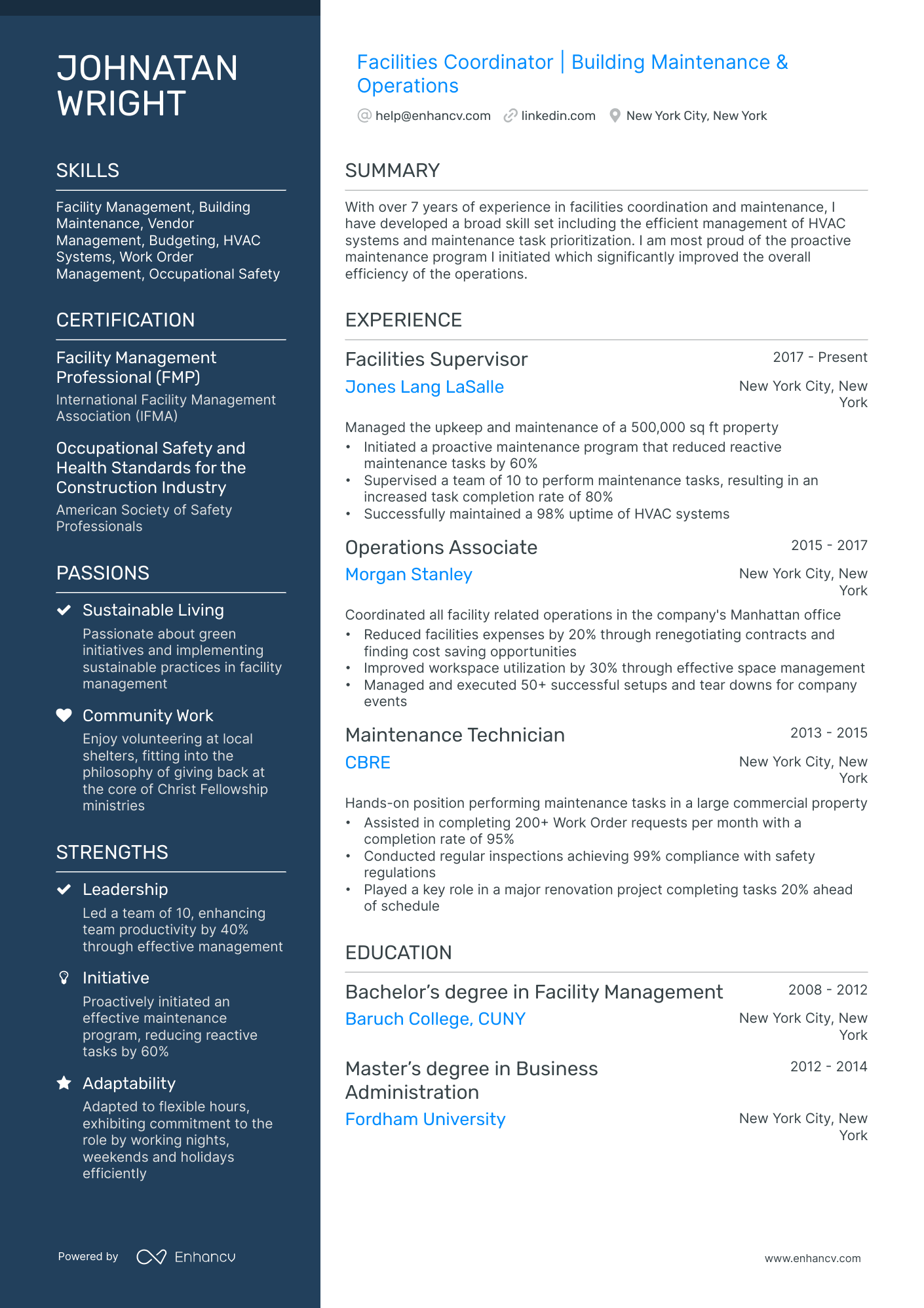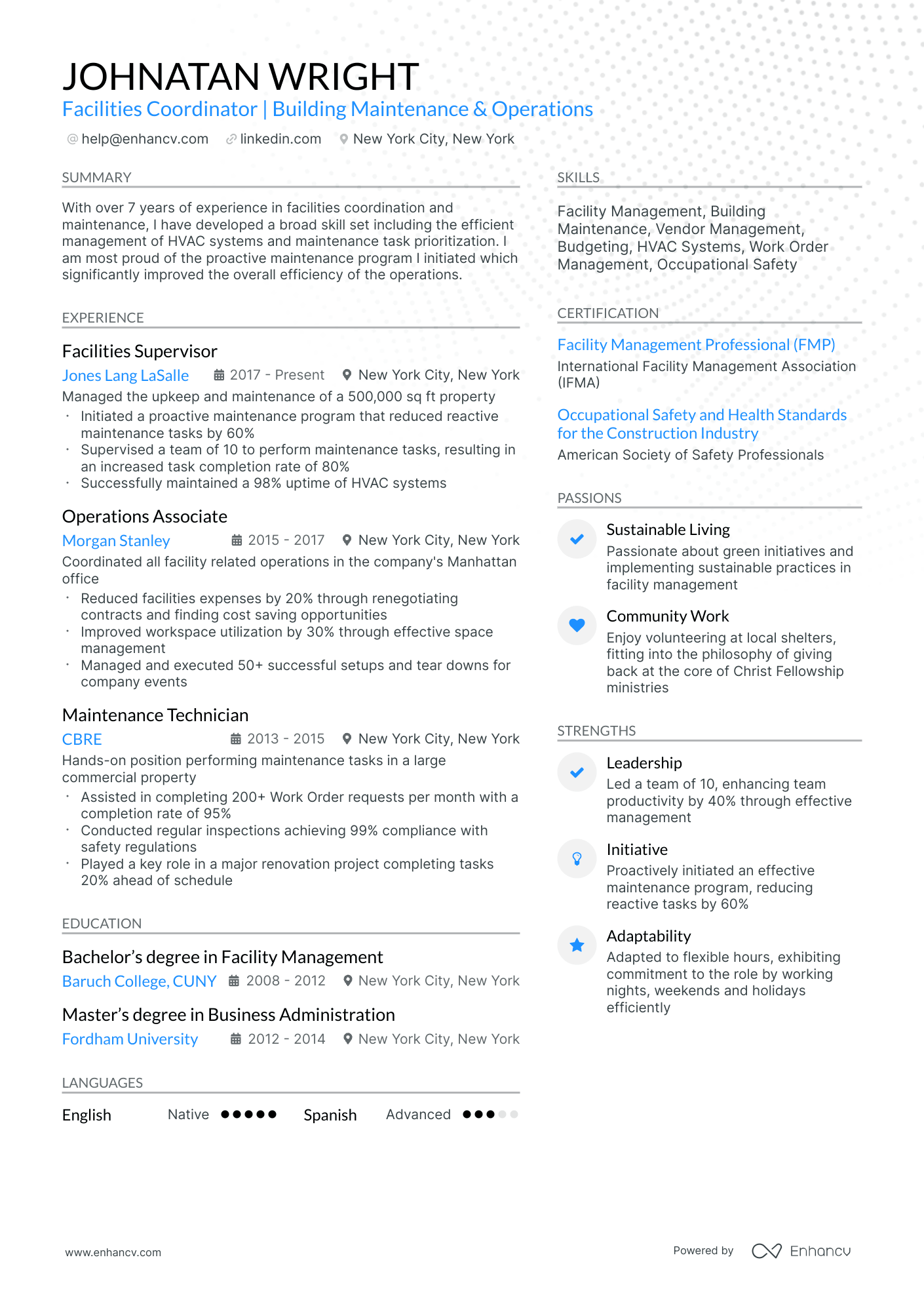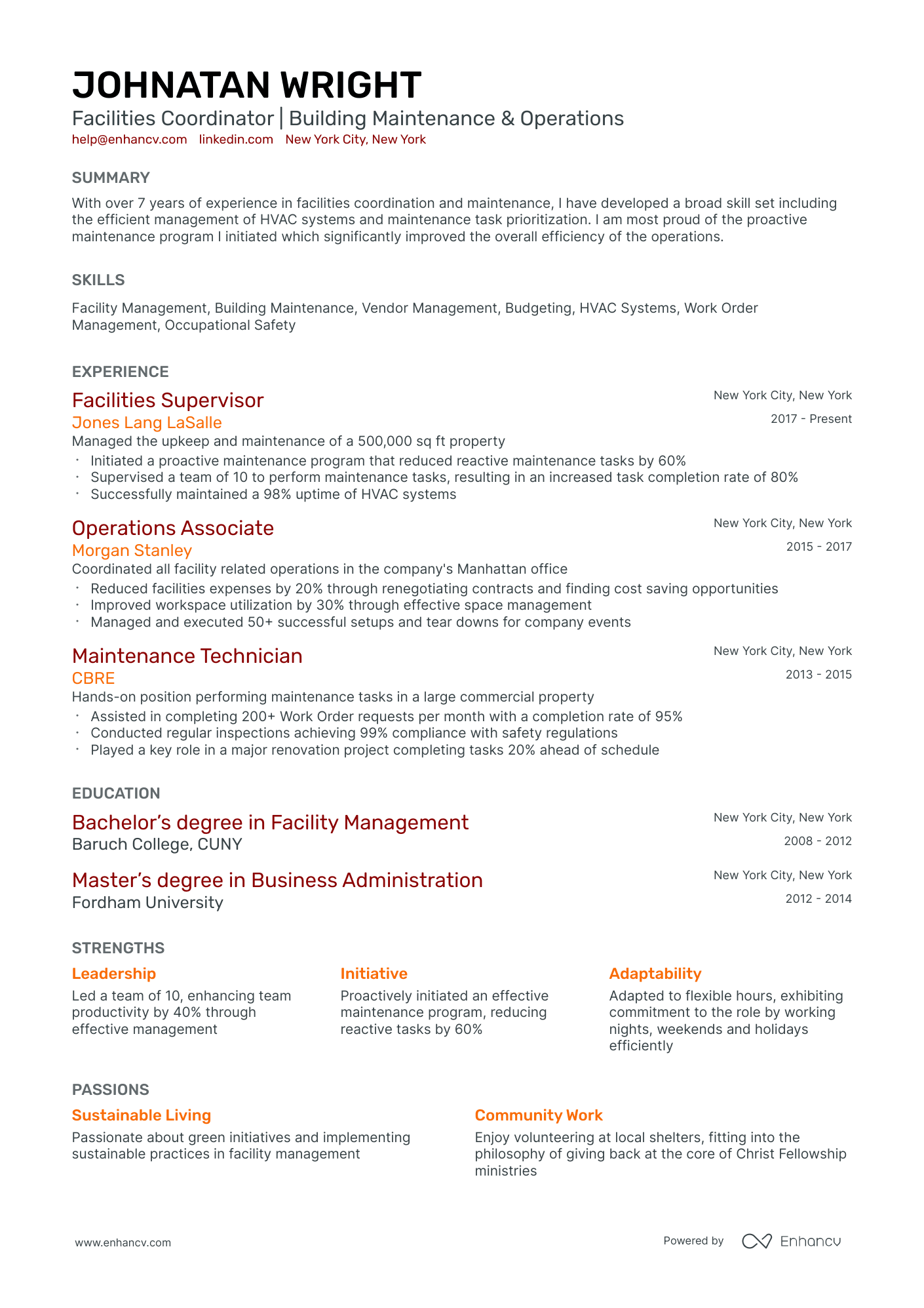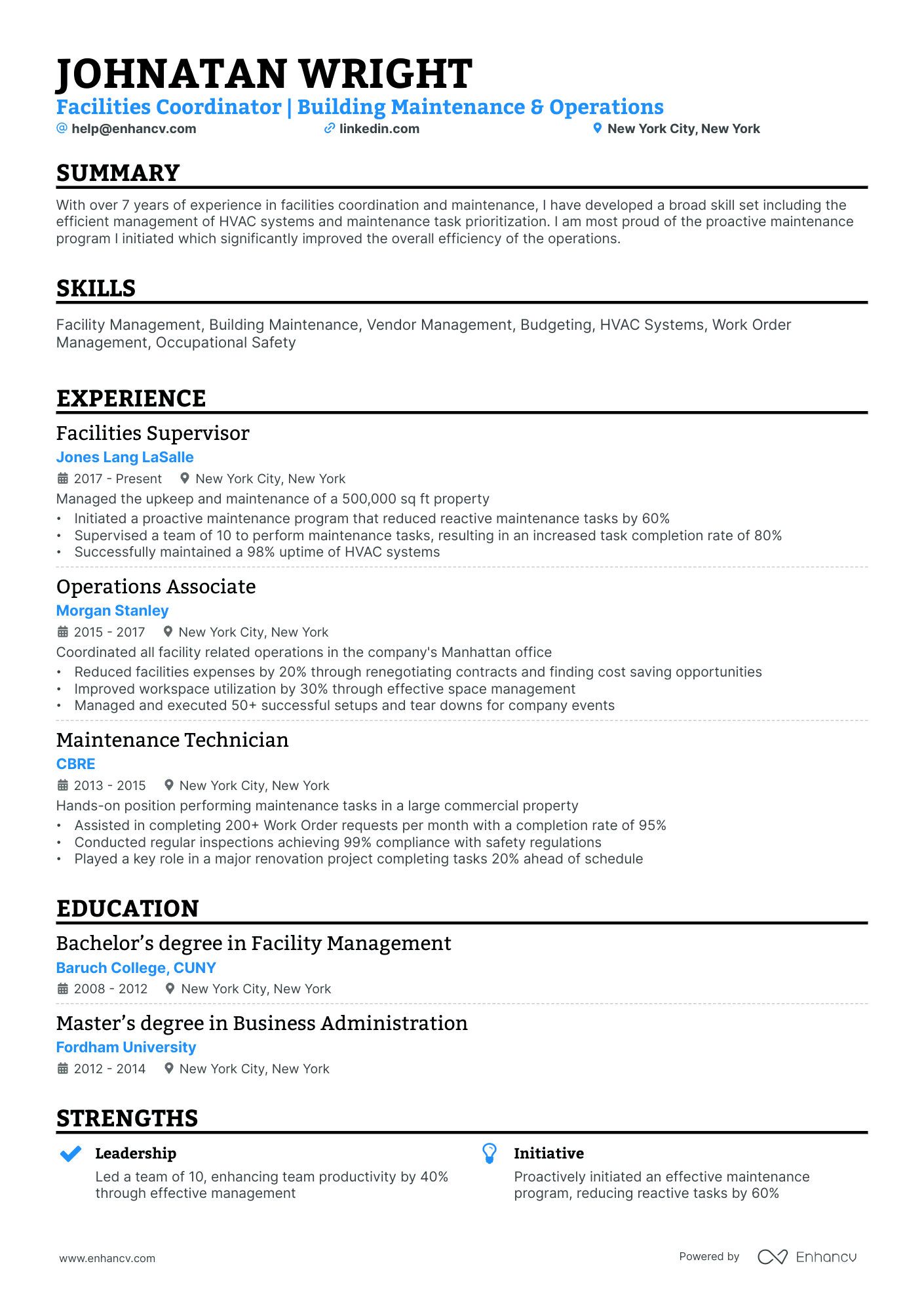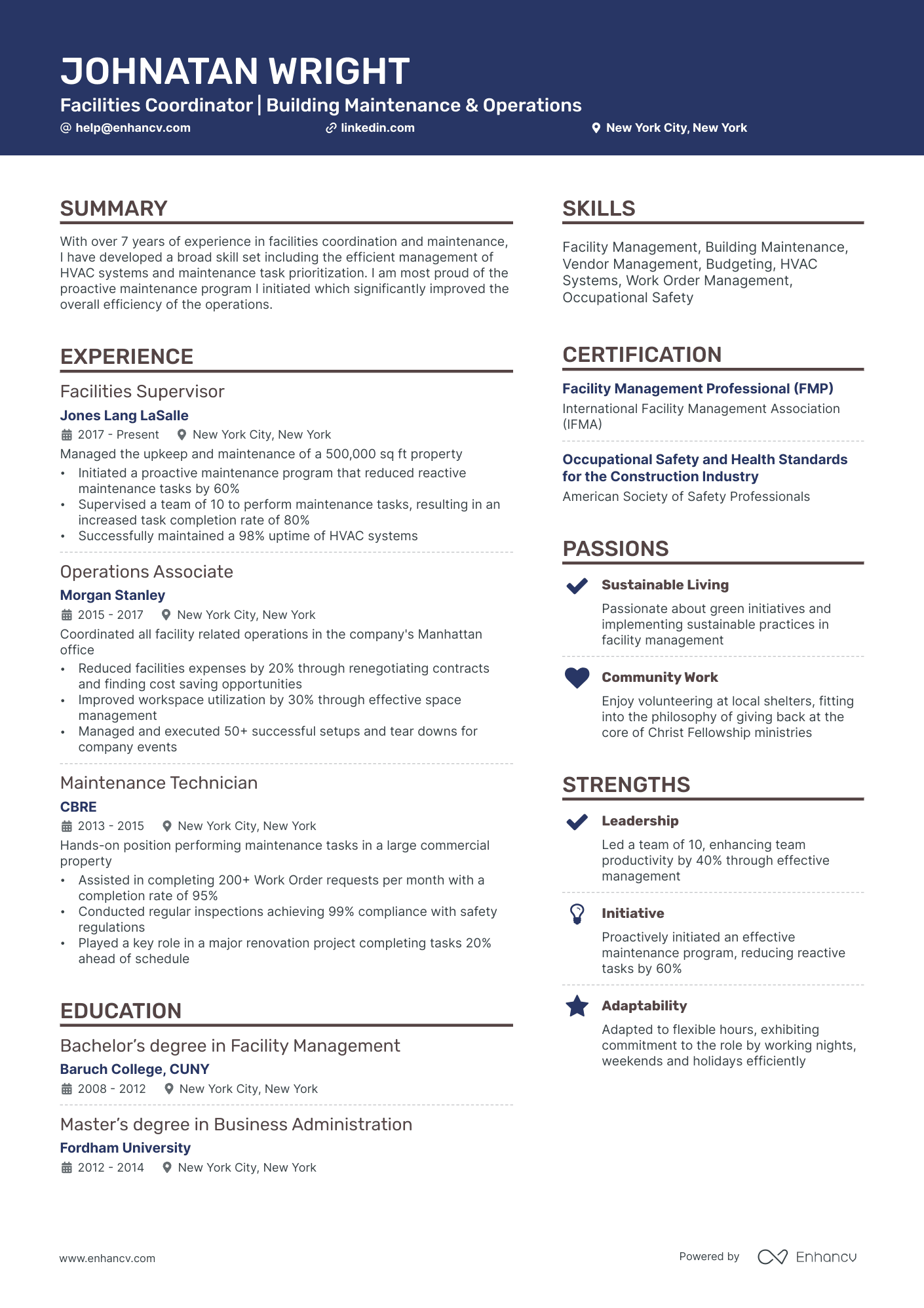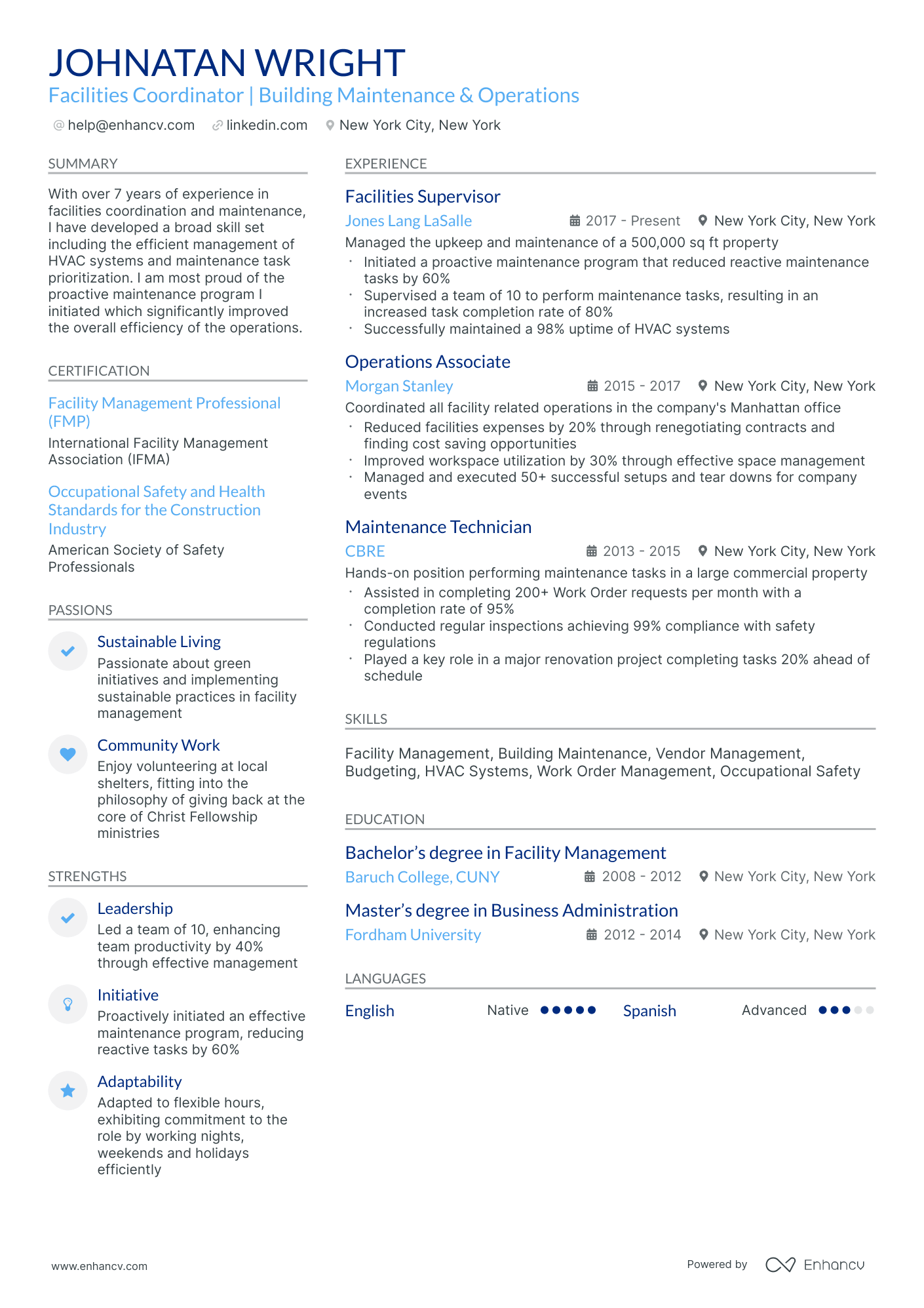One common challenge faced by a facilities coordinator when creating a resume is efficiently articulating the broad range of responsibilities, including project management, vendor coordination, and maintenance oversight, in a concise and impactful manner. Our guide can assist in addressing this challenge by offering targeted examples and templates that showcase how to effectively communicate diverse job responsibilities and achievements, highlighting your versatility and value to potential employers.
Here's what you'll read within our professional resume guide:
- Facilities coordinator resumes that are tailored to the role are more likely to catch recruiters' attention.
- Most sought-out facilities coordinator skills that should make your resume.
- Styling the layout of your professional resume: take a page from facilities coordinator resume examples.
- How to write about your facilities coordinator achievements in various resume sections (e.g. summary, experience, and education).
Recommended reads:
Designing your facilities coordinator resume: best practices
Before penning down your facilities coordinator resume, consider its structure and format. Here's what you should remember:
- Employ the reverse-chronological format to present your experience, starting with your most recent role.
- Your resume's header should feature accurate, professional contact details. If you maintain a professional portfolio or LinkedIn profile, include its link.
- Keep your resume concise, ideally within two pages. Prioritize relevance over length.
- Unless directed otherwise, save your resume as a PDF to preserve its design.
Upload your resume
Drop your resume here or choose a file. PDF & DOCX only. Max 2MB file size.
Pro tip
While color can enhance your facilities coordinator resume by emphasizing key details like headlines, job titles, and degrees, moderation is key. Stick to a primary and a secondary color to maintain professionalism and avoid a cluttered appearance.
Don't forget to include these six sections on your compensation analyst resume:
- A header for your contact details and a summary that highlight your alignment with the compensation analyst job you're applying for
- An experience section that explains how you apply your technical and personal skills to deliver successful results
- A skills section that further highlights how your profile matches the job requirements
- An education section that provides your academic background
- An achievements' section that mentions any career highlights that may be impressive, or that you might have missed so far in other resume sections
What recruiters want to see on your resume:
- Experience in Facilities Management: Proven experience in planning, directing, and coordinating supportive services of the organization. This might include tasks such as space allocation, facilities layout, and operational efficiencies.
- Project Management Skills: The ability to plan, execute, and oversee various projects within the organization's premises, such as renovations or relocations.
- Technical Knowledge: Familiarity with building systems, maintenance procedures, health and safety standards, and relevant laws and regulations.
- Vendor Management: Experience in negotiating contracts with vendors, managing relationships, and ensuring contracted services are executed effectively.
- Problem-Solving Abilities: Excellent problem-solving skills to handle unexpected issues smoothly and efficiently, minimizing their impact on the organization's operations.
Recommended reads:
Optimizing your facilities coordinator resume experience section
Your resume's experience section should resonate with your accomplishments while aligning with the job's demands. Here's how:
- Highlight significant career moments, and back them up with relevant skills.
- Analyze the job description to address both basic and advanced requirements.
- If you have unrelated roles, consider a separate section, but emphasize transferable skills.
- Avoid listing roles from over a decade ago unless they showcase your trajectory, especially for senior roles.
- Illustrate how your contributions enhanced the team or company, linking challenges to solutions.
Review how seasoned facilities coordinator professionals have crafted their experience sections, emphasizing their contributions.
- Coordinated and managed facility maintenance activities, ensuring timely completion of repair and maintenance tasks.
- Implemented cost-saving measures resulting in a 15% reduction in facility maintenance expenses.
- Developed and maintained relationships with vendors, negotiating contracts for services and supplies.
- Led a team of maintenance technicians, providing guidance and support to ensure efficient operations.
- Managed office relocations and space planning projects, coordinating with stakeholders to minimize downtime and disruptions.
- Oversaw the implementation of energy-efficient initiatives, resulting in a 20% reduction in utility costs.
- Created and maintained a preventive maintenance schedule, ensuring optimal functioning of equipment and systems.
- Managed the procurement of facilities equipment and supplies, optimizing inventory levels and reducing costs by 10%.
- Collaborated with cross-functional teams on space utilization projects, improving workspace efficiency.
- Developed and implemented emergency response plans, conducting regular drills to enhance preparedness.
- Streamlined facilities management processes, reducing response time to maintenance requests by 30%.
- Performed regular inspections of facilities, identifying and resolving safety hazards to ensure compliance with regulations.
- Coordinated office renovations, including managing contractors and overseeing the installation of new equipment.
- Developed and conducted training sessions on facility procedures and safety protocols for employees.
- Implemented a space utilization strategy, optimizing the office layout and increasing capacity by 15%.
- Managed the relocation of the company headquarters, coordinating all aspects of the move to ensure a seamless transition.
- Implemented a preventive maintenance program, reducing equipment downtime by 20% and extending their lifespan.
- Negotiated service contracts with vendors, resulting in a 10% cost savings while maintaining high-quality services.
- Collaborated with the HR department on workspace planning, ensuring optimal allocation of office space.
- Developed and implemented sustainability initiatives, achieving a 25% reduction in overall energy consumption.
- Implemented a computerized maintenance management system, improving tracking and reporting of facility maintenance activities.
- Conducted regular inspections of facilities, identifying areas for improvement and implementing necessary upgrades.
- Collaborated with cross-functional teams on workplace safety initiatives, resulting in a 40% decrease in accidents.
- Managed vendor relationships and negotiated contracts, ensuring cost-effective and reliable services.
- Led a sustainability task force, implementing eco-friendly practices resulting in a 30% reduction in carbon emissions.
- Coordinated facility maintenance projects, including HVAC upgrades and electrical system enhancements.
- Developed and implemented a space utilization strategy, optimizing office layout and reducing leasing costs by 15%.
- Managed the relocation of satellite offices, overseeing logistics and ensuring minimal disruption to business operations.
- Implemented a preventive maintenance program for critical equipment, resulting in a 25% decrease in unplanned downtime.
- Collaborated with architects and contractors on office renovation projects, ensuring compliance with design specifications.
- Managed day-to-day facilities operations, ensuring cleanliness, safety, and functionality of office spaces.
- Coordinated and supervised facility repairs and renovations, enforcing adherence to project timelines and budgets.
- Implemented a waste management program, reducing landfill waste by 20% through recycling and composting initiatives.
- Conducted regular audits of building systems, identifying energy-saving opportunities and implementing efficiency measures.
- Collaborated with HR and IT departments on office relocations, coordinating furniture installations and technology setups.
- Supported the planning and execution of facility maintenance projects, ensuring compliance with safety standards.
- Implemented a centralized inventory tracking system, optimizing stock levels and reducing procurement costs by 10%.
- Performed cost analysis on facilities-related expenses, identifying areas for cost reduction and expense optimization.
- Collaborated with cross-functional teams on office space redesign, maximizing space utilization and improving workflow.
- Managed vendor relationships, negotiating service contracts and resolving issues to maintain smooth operations.
- Developed and implemented a preventive maintenance program for critical equipment, minimizing unplanned downtime by 30%.
- Coordinated office space planning projects, optimizing seating arrangements and fostering a collaborative work environment.
- Managed facility-related budgets, tracking expenses and implementing cost-saving measures resulting in 10% savings.
- Collaborated with security teams on emergency preparedness plans, conducting drills and ensuring effective response procedures.
- Oversaw the implementation of sustainability initiatives, achieving LEED certification for the company's headquarters.
- Assisted in the coordination of facility maintenance activities, ensuring timely completion of repair and upkeep tasks.
- Maintained accurate records of maintenance activities, inventory, and service contracts using computerized systems.
- Supported office relocation projects, assisting with furniture setup and coordinating logistical requirements.
- Monitored and maintained office supplies inventory, replenishing stock as needed to ensure continuity of operations.
- Collaborated with team members on safety training sessions, promoting awareness and compliance with safety protocols.
The following content includes information from "O*NET OnLine" by the U.S. Department of Labor, Employment and Training Administration (USDOL/ETA). Used under the CC BY 4.0 license. The data represents the top responsibilities present on the task lists for facilities coordinator professionals.
Top Responsibilities for Facilities Coordinator:
- Monitor the facility to ensure that it remains safe, secure, and well-maintained.
- Oversee the maintenance and repair of machinery, equipment, and electrical and mechanical systems.
- Oversee construction and renovation projects to improve efficiency and to ensure that facilities meet environmental, health, and security standards, and comply with government regulations.
- Plan, administer, and control budgets for contracts, equipment, and supplies.
- Participate in architectural and engineering planning and design, including space and installation management.
- Set goals and deadlines for the department.
- Conduct classes to teach procedures to staff.
- Prepare and review operational reports and schedules to ensure accuracy and efficiency.
- Acquire, distribute and store supplies.
- Dispose of, or oversee the disposal of, surplus or unclaimed property.
Quantifying impact on your resume
<ul>
Strategies for candidates with limited resume experience
Lack of extensive experience doesn't mean you can't make a strong impression. Here's how:
- Thoroughly understand the role's requirements and reflect them in key resume sections.
- Highlight transferable skills and personal attributes that make you a valuable candidate.
- Use the resume objective to articulate your growth vision within the company.
- Emphasize technical alignment through relevant certifications, education, and skills.
Remember, your resume's primary goal is to showcase how you align with the ideal candidate profile. The closer you match the job requirements, the higher your chances of securing an interview.
Recommended reads:
Pro tip
When detailing your career journey, there's no need to delve deep into early roles. Prioritize what resonates with recruiters. For senior positions, a decade-long retrospective can effectively illustrate your evolution.
Decoding the essence of your facilities coordinator resume: hard and soft skills
Every job description communicates the desired hard and soft skills. These skills are the backbone of your application.
Hard skills are your tangible, technical proficiencies, often validated through certifications or hands-on experience. On the other hand, soft skills reflect your interpersonal abilities and how you navigate diverse work environments.
To effectively spotlight these skills on your resume:
- Create a distinct section for technical skills, listing the most relevant ones for the job.
- Highlight your strengths by weaving in achievements that underscore specific skills.
- Strike a balance between hard and soft skills to present a well-rounded profile.
- If multilingual, include a language proficiency section, emphasizing the interpersonal advantages it brings.
Stay tuned for a deep dive into the most in-demand hard and soft skills in the industry.
Top skills for your facilities coordinator resume:
Facilities Management Software
AutoCAD
Microsoft Office Suite
Building Management Systems (BMS)
Project Management Tools
Inventory Management Systems
Space Planning Software
HVAC Systems Knowledge
Safety Compliance Regulations
Vendor Management Systems
Communication
Problem-Solving
Time Management
Team Collaboration
Attention to Detail
Customer Service
Adaptability
Planning and Organizing
Negotiation
Conflict Resolution
Next, you will find information on the top technologies for facilities coordinator professonals from "O*NET OnLine" by the U.S. Department of Labor, Employment and Training Administration (USDOL/ETA). Used under the CC BY 4.0 license.
Top technologies for Facilities Coordinator’s resume:
- Microsoft Dynamics
- Oracle PeopleSoft
- Google Docs
- Microsoft Word
- Email software
- Microsoft Outlook
Pro tip
When detailing your skills, align them with the job's requirements. Emphasize unique technical proficiencies and provide examples of your soft skills in action.
Choosing the right certifications and education for your facilities coordinator resume
Your education section can highlight skills and experiences perfect for the job.
- List college or university degrees with the school name and dates.
- If you're still studying, mention your expected graduation date.
- Think twice before adding unrelated degrees. Space on your resume is precious.
- Discuss educational achievements if they boost your job relevance.
There are many certifications out there. Which ones should you include?
- List your main degree in a separate section with the school name and dates.
- Only add certifications that highlight your skills and experience.
- Place unique or recent certifications near the top.
- Add a brief description to certifications if it helps show your skills.
Remember, it's not about quantity but relevance.
Best certifications to list on your resume
Pro tip
List your degrees in reverse order, starting with the newest. A recent PhD or unique field could set you apart.
Recommended reads:
Summary or objective: maximizing the impact of the top third of your resume
The top third of your facilities coordinator resume is crucial. It's often the first thing recruiters see and can set the tone for the rest of your application.
Whether you choose a resume summary or a resume objective, make it count. The former is great for showcasing career highlights, while the latter balances your achievements with your future aspirations.
Both should be tailored to the role, as there's no universal approach to crafting the perfect facilities coordinator summary or objective. Use the examples below as a starting point.
Resume summary and objective examples for a facilities coordinator resume
With a solid 7-year background in operations management, I have developed superior technical skills in equipment maintenance, as well as scheduling and vendor relations. Spearheaded a cost-saving initiative that saved $50k annually at my previous company.
Holding an 8-year tenure in the role of Project Manager for reputable firms, I've honed the ability to effectively plan, organize, and manage resources. Successfully delivered projects under tight deadlines while reducing operation costs by 15% annually.
Qualified Mechanical Engineer with 5 years of experience, seeking to leverage my proficiency in AutoCAD and facility management into a facilities coordinator role. Proven track record of successfully managing complex mechanical projects from conception to completion.
Experienced Administrative Assistant eager to shift career towards Facilities Management. Recognized for exceptional organizational skills and focus on efficiency, looking forward to applying these in maintaining optimal facility functionality.
Passionate about building operations and maintenance, eager to apply my knowledge and learn more as a facilities coordinator. My intent is to contribute positively to the operational efficiency of the organization, utilizing my detail-oriented nature and strong problem-solving abilities.
Aiming to kickstart my career in Facility Management. With a degree in Business Administration and a knack for problem-solving, I aim to provide comprehensive support to the team in ensuring smooth day-to-day operations and enhancing overall productivity.
Additional facilities coordinator resume sections for a personalized touch
To further personalize your facilities coordinator resume, consider adding sections that reflect your unique qualities and achievements.
Popular choices include:
- Projects to showcase significant work achievements.
- Languages to indicate proficiency levels.
- Awards to celebrate industry recognitions.
- Hobbies and Interests to share personal passions.
Key takeaways
- A clear resume layout helps present your info well.
- Use all main resume sections to show how you fit the job.
- Detail specific skills or tasks and their impact.
- Show your personality through interests or hobbies.
- List certifications to back up your technical skills.
